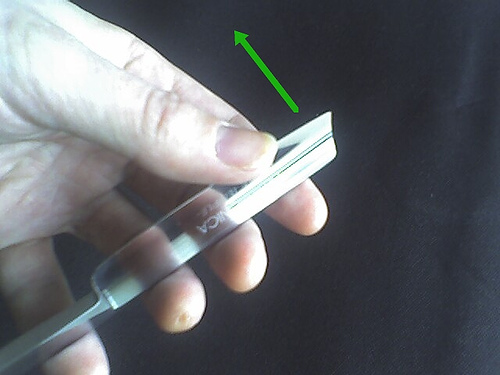Results 11 to 15 of 15
-
05-28-2009, 04:11 AM #11

One way to "calibrate" your TPT "feel" is the way I use when teaching someone to hone knives.
Take a DE blade and do one shave with only one side of it. Remove the blade. Even a brand new honer should be able to feel the difference in the two sides; using the TPT. Even though both sides are usually still sharp enough for a shave, the difference is very noticeable.
The TPT can detect even minor variations in an edge, with a little practice.
-
The Following User Says Thank You to Sticky For This Useful Post:
pjrage (05-28-2009)
-
05-28-2009, 11:41 AM #12Stubble Slayer

- Join Date
- Jan 2009
- Location
- Alexandria, VA
- Posts
- 708
Thanked: 171
-
05-29-2009, 12:43 AM #13
-
05-30-2009, 10:27 PM #14---

- Join Date
- Jan 2009
- Posts
- 1,230
Thanked: 278
I'm reluctant to post this, maybe I should just let it be, but the Wiki defines the TPT as per this picture:

Is this widely accepted as what we mean when we talk about THE thumb pad test?
I place emphasis on "the" because I can think of at least 2 other ways to do the TPT. But only one of them can be the standard test that we want people to understand when we use the phrase.Last edited by Rajagra; 05-30-2009 at 10:30 PM.
-
05-31-2009, 01:45 AM #15

Good eye. For me and every barber I've ever known, the TPT is done by using your thumb or any finger pad (moistened or dry) drawn along the edge; not across it as in the wiki. The '61 barber manual also says "along the edge", not across it. Just touching the edge using no noticeable movement at all will feel "sticky" if the edge is extremely sharp.
All the knife and wood tool honers that I know also draw the pad along the edge, not across it, as a sharpness test. As does Heavydutysg135 in his excellent TPT posts and videos.
Drawing the pad across the edge is only useful to me if it is in the same plane as the blades major surface. i.e. a burr test.


 LinkBack URL
LinkBack URL About LinkBacks
About LinkBacks






 Reply With Quote
Reply With Quote
 I wonder if there might be another way to slightly dull one side of a DE blade without having to touch my face with it
I wonder if there might be another way to slightly dull one side of a DE blade without having to touch my face with it 
